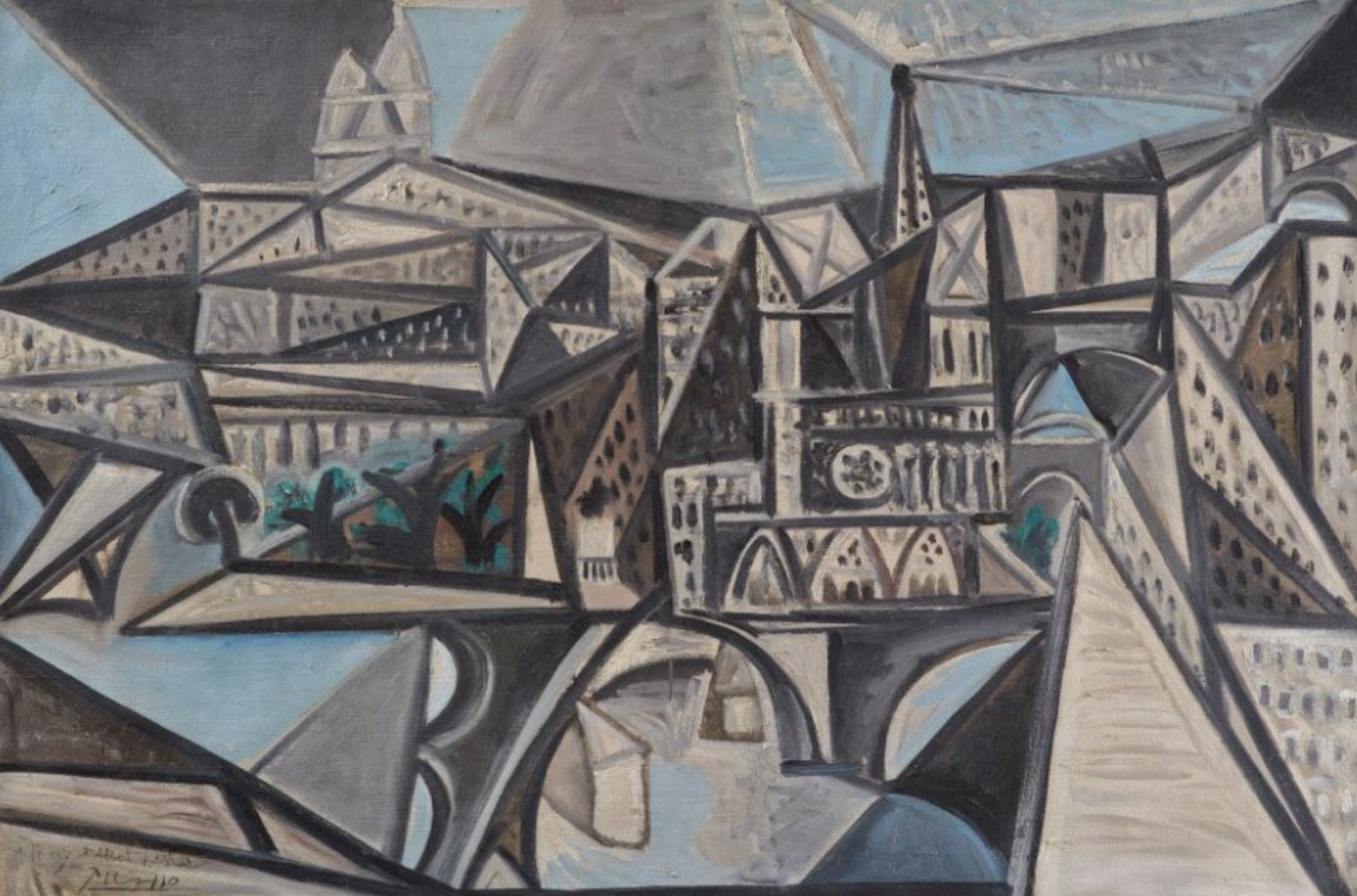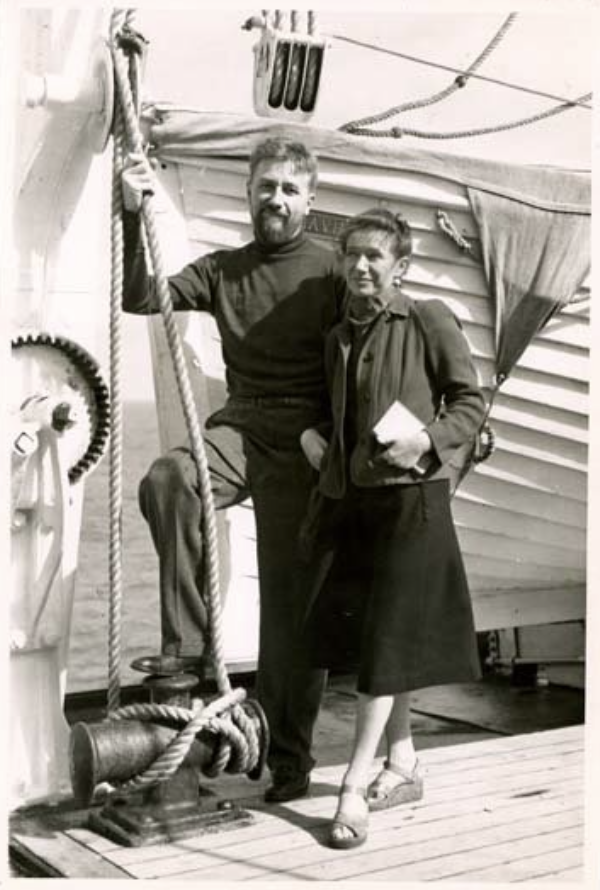FROM THE ARCHIVE: Biala and the Notre Dame paintings
Biala (1903-2000), Notre Dame II [CR 040], 1985, Oil on canvas, 51 x 77 in (132.1 x 195.6 cm) Collection of the Estate of Janice Biala, New York
As an icon of Gothic architecture, the Cathedral of Notre-Dame has inspired artists for centuries. Many artists, among them Henri Matisse and Pablo Picasso, would return again and again to the same vantage point throughout their careers to paint its towering magnificence.
Pablo Picasso (1881-1973) Île de la Cité—View of Notre-Dame de Paris (February 26, 1945), 1945, Oil on canvas, 31.5 x 47.2 in (80 x 120 cm), Collection of the Museum Ludwig, Köln © 2022 Estate of Pablo Picasso / Artists Rights Society (ARS), New York. Used with permission.
Biala (1903-200), Le Louvre [CR 753], 1948, Oil on canvas, 36 x 28 1/4 in (91.4 x 71.8 cm) Collection of the Estate of Janice Biala, New York.
Biala and her husband Daniel Brustlein boarding French Line’s SS de Grasse for Europe, 1947. Courtesy Tworkov Family Archive, New York.
Picasso, in particular, painted Notre Dame—bending the buildings, the bridges and the river into the Cubist style that he pioneered. This work, Île de la Cité-vue de Notre-Dame de Paris, painted in 1945 after the Second World War, captures Notre Dame in a softer and looser style with muted pastel colors, possibly reflecting a lighter mood of the recently liberated city.
Two years later, in the fall of 1947, Biala would return to Paris aboard French Line’s SS de Grasse—one of the first passenger boats to sail to Europe after the war. Having spent a decade alongside the English Novelist Ford Madox Ford, her return was a joyous one, “I still find in France all the things I’d hoped for. I’d have no use for Paradise if it wasn’t like France.”(1)
Using initially the studio of a new friend, the photographer Henri Cartier-Bresson, and much preferring the more “human” aspects of European life, Biala began painting the City of Light from various views and perspectives. “I hadn’t known when I was in New York, that the skyscrapers were weighing on me,” she said in a 1989 interview that featured herself, Shirley Jaffe, and Joan Mitchell. In Paris, she “felt as if they had suddenly fallen off.” For Biala, Paris was “extremely beautiful and paintable.”(2)
Le Louvre, 1948, is one of the first paintings to capture the architecture of her adopted city. This masterwork features a view of the city from the Left Bank looking North across the Seine with views of the the Louvre and the Jardins des Champs-Élysées. More specifically, Pavillon de la Trémoille appears on the upper left and the various rooftops that make up the Louvre filling the horizon. Pont de Arts stretches horizontally through the painting’s center left. Framing the composition is an iron railing in the near foreground.
It didn’t take long for the Parisians to take notice of her return. In the summer of 1949, Galerie Jeanne Bucher, held her second solo exhibition in Paris—the first being in 1938 at Galerie Zak. ARTnews championed the work for its depiction of “reflected, part-dream worlds,” and, “her great sensitiveness to color, especially in the handling of yellow,” and her, “interest in peaceful things such as house-fronts, windows, life above street-noises.”(3) Later the same summer Biala became the only American among eighteen candidates selected to participate in the Prix de la Critique, receiving a special honorable mention.
White Façade [CR058], 1948, Oil on canvas, 39 x 32 in (99.1 x 81.3 cm) and Pink Façade [CR 057], 1949, Oil on canvas, 39 x 32 in (99.1 x 81.3 cm) Collection of the Estate of Janice Biala, New York
White Façade [CR 058], 1948 and Pink Façade [CR 057], 1949, are examples of the “house-fronts” mentioned in the review and were likely inspired by the apartment building Biala was renting at 52 rue de Bourgogne or a combination of façades the artist remembered from walking the city.
Certainly included in her show at Jeanne Bucher, was Biala’s Chevet de Notre Dame et e Ile St. Louis, 1949. While Picasso and Matisse and other artists preferred the more popular perspective from the West looking East towards Île de la Cité, Biala preferred to capture the cathedral from the East looking West from the Île Saint Louis.
Chevet de Notre Dame et e Île St. Louis [CR 062], 1949, Oil on canvas, 35 x 45 1/2 in (88.9 x 116.8 cm) Collection of the Estate of Janice Biala, New York.
Chevet de Notre Dame et e Île St. Louis, is the earliest known painting by Biala of Norte Dame. Its perspective is unique, composed as if on a boat on the Seine or from the Post de la Tourney. The painting looks West towards the cathedral capturing the point where the Seine breaks around the Île de la Cité with Pont de l’Archevêché and the cathedral to the left and the Île Saint Louis to the right. Although a smaller study for this painting exists, it is unlikely that Biala painted this work (or any others) on site en plein air. It is more likely that she painted the work from a sketch or even from memory. It’s a gloomy painting developed around a palette of warm earthy hues of ochre and sage.
It is interesting to note that that summer, Biala met again Matisse spending “2 1/2 hours in his house in the company of a Life photographer who was taking pictures of him.”(4) The next day, she met Picasso again, shaking his hand.
“Paris la nuit [CR 069],” 1957, Oil on canvas, 31 x 58 1/2 in (81.3 x 148.6 cm) Collection of the Estate of Janice Biala, New York
Study for “Paris la nuit [CR 413],” c.1957, Graphite on paper, 17 x 22 in (45.7 x 55.9 cm) Collection of the Estate of Janice Biala, New York
Paris at night became the subject of two paintings dating from 1954. Similar in composition, one larger than the other, both prominently feature a bridge over the Seine. Among the gesturally painted even impressionistic midnight scene are edges of rooftops and flares of architectural details. A close study of Paris la nuit, 1957, reveals that the bridge featured is Pont du carrousel which was also a favorite of her mentor and friend Edwin Dickinson.
Biala, Notre-Dame I [CR134], 1985, Oil on canvas, 47 x 51 in (119.4 x 132.1 cm) Collection of the Estate of Janice Biala, New York
Three decades separate the next series of paintings featuring Notre-Dame. In her studio records, Biala noted four large paintings in a series she completed in 1985, two of which remain with the Estate. In the series, Pont de L’Archevêché appears prominently with the river Seine in the foreground and the towers of the cathedral. In all, the composition and palette remains quite minimal, with the bridge creating an arching horizon. Soft creamy whites and subtle hues of blue make up a consistent palette.
Biala on the left bank of the Seine, Port de Montebello, Paris, June 1979. Courtesy Tworkov Family Archives, New York
“I fell in love with France,” Biala said, “In some ways, it reminded me of the place I was born in. And when I came to France I felt as if I had come home. I smelled the same smells of bread baking and dogs going around in a very busy way, you know, as if they knew what they were about. It really was extraordinarily human.”
A photograph of Biala, taken in the summer of 1979, captures the artist at Port de Montebello at river’s edge, possibly one of the artist’s favorite and most inspiring points in Paris.
_____
1. Letter to Jack Tworkov from 65 Blvd de Clichy, Paris, December 3, 1947.
2. Brenson, Michael. “Three Artists Who Were Warmed by the City of Light.” The New York Times, Sunday, June 25, 1989, 31, 32.
3. Cunard, Nancy. "Janice Biala at Galerie Jeanne Bucher." Art News (July 17, 1949).
4. Letter to Wally Tworkov. July 31, 1949.









